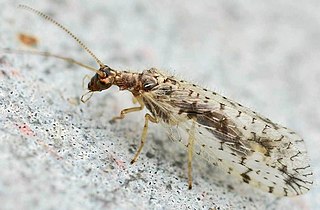
The insect order Neuroptera, or net-winged insects, includes the lacewings, mantidflies, antlions, and their relatives. The order consists of some 6,000 species. Neuroptera can be grouped together with the Megaloptera and Raphidioptera in the unranked taxon Neuropterida including: alderflies, fishflies, dobsonflies, and snakeflies.

Green lacewings are insects in the large family Chrysopidae of the order Neuroptera. There are about 85 genera and 1,300–2,000 species in this widespread group. Members of the genera Chrysopa and Chrysoperla are very common in North America and Europe; they are very similar and many of their species have been moved from one genus to the other time and again, and in the nonscientific literature assignment to Chrysopa and Chrysoperla can rarely be relied upon. Since they are the most familiar neuropterans to many people, they are often simply called "lacewings". Since most of the diversity of Neuroptera are properly referred to as some sort of "lacewing", common lacewings is preferable.

Osmylidae are a small family of winged insects of the net-winged insect order Neuroptera. The osmylids, also called giant lacewings, are found all over the world. A common species through most of Europe is Osmylus fulvicephalus.

Hemerobiidae is a family of Neuropteran insects commonly known as brown lacewings, comprising about 500 species in 28 genera. Most are yellow to dark brown, but some species are green. They are small; most have forewings 4–10 mm long. These insects differ from the somewhat similar Chrysopidae not only by the usual coloring but also by the wing venation: hemerobiids differ from chrysopids in having numerous long veins and forked costal cross veins. Some genera are widespread, but most are restricted to a single biogeographical realm. Some species have reduced wings to the degree that they are flightless. Imagines (adults) of subfamily Drepanepteryginae mimic dead leaves. Hemerobiid larvae are usually less hairy than chrysopid larvae.

Chrysopinae is a subfamily of green lacewings in the insect family Chrysopidae in the order Neuroptera. They are the nominate taxon and largest member of the green lacewing family (Chrysopidae), containing about 60 genera.

Chrysopa perla is an insect species belonging to the green lacewing family, Chrysopidae.

Chrysoperla lucasina is a species of neuropteran of the family Chrysopidae. They are found mainly in the United Kingdom, the Czech Republic, France, Germany, Greece, Italy, Spain, Portugal, Switzerland, in western Asia and northern Africa.
Ceraeochrysa is green lacewing genus in the family Chrysopidae, containing the following species:

Semachrysa is a genus of green lacewing found from Japan to Australia along the Western part of the Pacific Ocean. 20 Semachrysa species have been described between 1914 and 2012. 15 of them - one of which was new - have been included in a recent taxonomic study:

Buprofezin is an insecticide used for control of insect pests such as mealybugs, leafhoppers and whitefly on vegetable crops. It is a growth regulator, acting as an inhibitor of chitin synthesis. It is banned in some countries due to its negative environmental impacts, being especially toxic to aquatic organisms as well as non-target insects, though is of low toxicity to humans and other mammals.
Chrysopophthorus hungaricus is a species of wasp in the family Braconidae. It is found in North Italy. It is also found in Great Britain as an introduced species. It is a parasitoid of adult Chrysopidae (Neuroptera).

Ceraeochrysa lineaticornis is a species of green lacewing in the family Chrysopidae. It is found in North America.

Chrysopini is a tribe of green lacewings in the family Chrysopidae. There are about 17 genera and at least 300 described species in Chrysopini.
Eremochrysa pallida is a species of green lacewing in the family Chrysopidae. It is found in North America.
Eremochrysa is a genus of shadow lacewings in the family Chrysopidae. There are about 18 described species in Eremochrysa.

Abachrysa is a genus of green lacewings in the family Chrysopidae. There is one described species in Abachrysa, A. eureka.

Leucochrysa is a genus of green lacewings in the family Chrysopidae. There are more than 180 described species in Leucochrysa.
Yumachrysa is a genus of green lacewings in the family Chrysopidae. There are at least four described species in Yumachrysa.
Ceraeochrysa smithi is a species of green lacewing in the family Chrysopidae. It is found in the Caribbean Sea, Central America, North America, and South America.











